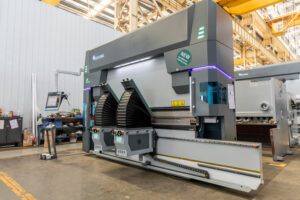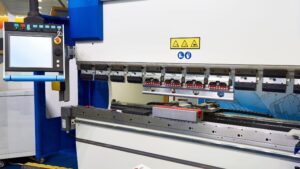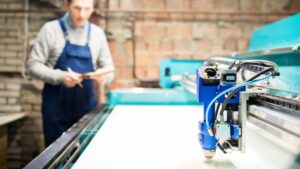Press brakes are heavy industrial equipment that requires regular maintenance. Understanding the process of press brake maintenance is an essential part of owning and using a press brake. Professionals considering buying a new press brake should learn its maintenance requirements beforehand.
This article will have an in-depth discussion on how to maintain press brakes. You will learn invaluable information like the maintenance work, steps, precautions, frequency, and many other things.
Press Brakes Overview
A press brake is a type of industrial machine used for bending sheet and plate metal. It relies on a heavy ram that applies force on the workpiece at the point of contact, creating the bend.
There are many options for generating force and moving the ram. This results in many different types of press brake, such as hydraulic system, servomotor press brake, and mechanical press brake.
Importance of Press Brake Maintenance
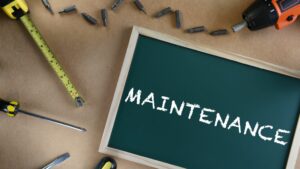
Following a regular press brake maintenance cycle is mandatory for every setup. Press brakes are heavy industrial equipment.
As such, they are prone to wear and tear of the daily operation. Maintenance work ensures that all system parts are in optimal working order.
Skipping on maintenance can lead to the breakdown of machine mid-operation. This can result in significant losses due to downtimes. Additionally, press brakes that aren’t maintained can also become a safety hazard.
What are the Tools and Equipment Required For Press Brake Maintenance?
Press brake maintenance does not require any sophisticated equipment. There are only some simple things required. Most of them are available in every workshop.
- Gloves: Gloves are mandatory when conducting operations such as lubing and cleaning. The press brake machinery can have a lot of sharp corners. Additionally, there are chemicals in the lube that can be harmful to the skin.
- Brush: You require a brush to lubricate the press brake machinery.
- Cleaning Tools: Cleaning tools include a cloth for wiping the machine clean. Some parts of the machine, such as the tooling, require alcoholic solvents to remove the oil accumulated due to handling. Electrical parts of the press brake wiped with liquid solvents can create electric shocks. Therefore, use the cleaning solutions cautiously only where they are applicable.
- Measuring Instruments: The main purpose of the measuring instruments is to calibrate the components, like the back gauge.
- Torque Wrench: A torque wrench is required to open and tighten nuts around the machine.
- Electrical Testing Equipment: Electrical testing equipment is needed to inspect the press brake’s electrical cabinets. It also checks the electrical connections around the machine.
- Containers: Clean containers are needed during the cleaning of the oil tank. The oil is stored in the containers temporarily before shifting it back to the tank.
- Air Blower: Light air blower may be needed to blow the dust away from the electrical cabinet.
Regular Press Brake Maintenance Tasks
Here are some of the tasks that are performed regularly during press brake maintenance:
Cleaning
Cleaning is an important maintenance work when it comes to press brake. Accumulation of dirt can cause an increase in friction in the internal components of the machine. This results in an increased probability of part breakdown. In addition to keeping the press brake machine clean, it is also important to clean the work area. A clean work area will reduce the frequency of cleaning the machine.
The cleaning process is an everyday requirement. The operator should wipe the machine with a clean cloth before beginning the daily work operation. Cleaning of safety precautions like laser curtains is also crucial. Accumulation of dirt in the laser sensor can result in its malfunction.
Lubrication
Lubrication of press brake components reduces the friction of parts during operation. This improves the machine’s performance and increases the lifetime of parts. The lubricant also acts as a heat exchanger for dispersing the high temperature in the machine’s internal components.
Press brakes have multiple lubrication holes where the operator can use the appropriate lubricant. The frequency of the lubrication varies for different parts. Some parts require weekly lubrication. Other parts, like the guides of the mobile beam, require yearly lubrication.
Are there any specific lubrication requirements for the press brake?
Yes, there are specific lubrication requirements for every press brake. These requirements vary from machine to machine based on the type of press brake and the design of the machine. A common requirement for all press brakes is to avoid over-lubrication.
Over-lubrication causes the accumulation of dust and dirt between the moving machine parts. Press breaks generally use lithium grease, silicone grease, synthetic non-petroleum lube, or dry film graphite lubrication.
Inspection
Press brake inspection ensures that all the parts and features of a press brake are in working order. The operator inspects at regular intervals. A press brake should be inspected at a standstill and during machine operation to ensure the correct working of the moving parts.
The best way to carry out press brake inspection is to create a checklist of the various areas that require checking. Any areas of interest or problems can be noted down in the checklist. The checklist should also contain the details of the scheduled maintenance.
Back Gauge Calibration
The purpose of the back gauge is to ensure the workpiece is placed correctly to create a precise bend. After many bends, the back gauge can deviate from its position. Therefore, regular back gauge calibration is essential to make bends with high accuracy. Back gauge calibration is done by creating a test bend. The back gauge can be adjusted according to the deviation present in the test bend.
Hydraulic Oil System Maintenance
Hydraulic press brakes have added maintenance requirements for parts like pistons and pumps. Without maintenance, hydraulic systems can face issues such as oil leakage or hydraulic pump malfunction. Common maintenance steps for hydraulic systems include oil top-ups, checking leaks, cleaning, and emptying valve panel drip pans.
Electrical System Maintenance
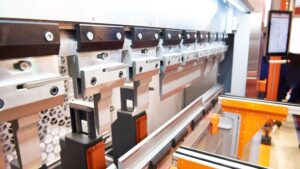
Maintenance of the electrical system of press brakes requires extreme caution. Any chemicals or liquid cleaning solutions should never be used to clean the electrical system. Instead, using compressed air with a pressure limited to 3 bars is better. Tighten the electrical connections if they feel loose. The electrical cabinet and inverter box contain an air filter for dust protection. Clean this filter for proper ventilation.
Important Precautions For Press Brake Maintenance
There are certain precautions you should take when maintaining a press brake. These precautions are essential for the safety of the machine and the operator.
Don’t use flammable materials for cleaning. Press brakes generate a lot of heat during operation. This can cause flammable materials to catch fire.
Do not spill the cooling lubricant in the environment.
Ensure the machine is completely standstill before accessing the inner parts for maintenance.
Disconnect the machine from the main supply during the maintenance of electrical connections.
Maintenance work often requires the disassembly or disabling of the guards. Ensure the guards are put together correctly when the maintenance work is complete.
Not every machine part can withstand the weight of a person. Therefore, use special equipment instead of standing on the machine chassis.
How to Maintain a Press Brake?

Follow the below guidelines to maintain your press brake and keep it in the best condition:
- Start every maintenance work with a cleaning of the press brake. Use a clean cloth to wipe the machine and the die table. Clean the supports, tools, side guide rails, and the press brake bench.
- Change the air filters of the machine regularly. The air filter can be cleaned a few times until it becomes permanently clogged and has reduced performance. At this stage, changing the air filter is a must.
- Inspect the electrical connections regularly. If there are sparks, you need to tighten the connections. Ensure that there is proper insulation on every connection.
- Refer to the machine manual to learn about the various parts of the press break that require lubrication. Apply the grease with a brush. The lubrication points vary based on the type of press brake. For instance, in the case of a hydraulic system, you will need to grease nipples of the mechanism.
- Back gauges routinely deviate from their intended position. Regularly ensure that the back gauge is calibrated and parallel to the beam.
- Make sure the tooling system of the press brake locks tightly. Any wobbling in the tooling system can lead to poor results.
- Tighten the bolts of the machine when the maintenance procedures finish. Any loose bolts can result in machine damage or operator injury.
How to Maintain the Hydraulic System of a Press Brake?
Follow the steps below for the inspection and maintenance of the hydraulic system:
- Use the oil tank indicator to check the hydraulic oil level. Any air bubbles or insufficient oil level will lead to breaks in performance and damage to the oil pumps.
- Some press brakes come with a hydraulic tool clamping system. These brakes have a dedicated oil level indicator to check the amount of fluid. Inspect this indicator separately.
- Shift the piston to the upper position when making adjustments to the hydraulic oil level. This prevents the overflowing of the oil.
- If the oil gets contaminated, you will need to replace all the oil. Contaminated oil causes significant damage to the pump and valves. The degradation of valves commonly causes leaks in the system due to these particles.
- Refer to the manufacturer user manual for the press brake machine to know which hydraulic oil to use. Different hydraulic oils have varying viscosity and other physical properties.
- Conduct a deep cleaning of the hydraulic circuit after 2000 hours in service. This includes deep cleaning the tank and suction filters. The entire hydraulic oil requires replacement after 2000 operating hours. After the first replacement, change the oil after a period of 5000 operating hours.
- Hydraulic systems come with pressure relief valves to regulate the maximum pressure. Use these valves if the hydraulic pressure exceeds the value recommended by the manufacturer.
How Often Should You Maintain Your Brake Press?

Daily Overview Procedures
- Clean the entire equipment and work area in the beginning of the day’s operation.
- Calibrate the back gauge by making a test bend.
- Visually inspect the machine.
- In the case of a hydraulic circuit, check for leaks.
- Clear the valve panel drip pan.
- Inspect the three position down pedal to see if it is in optimal state.
- Wear gloves and wipe the processing residue with a cloth.
Weekly Overview Procedures
- Check the protection and safety measures to make sure everything is working correctly.
- Check the functioning of the emergency stop button.
- Check the rear guard and the side guards.
- Check the air filters. Some filters have an indicator for contamination. Replace the filter if the indicator suggests so.
- Tighten the valves and nuts around the pump.
- Create entries in the service book about the maintenance and repairs done. Note down any areas of interest.
Monthly Overview Procedures
- For the pneumatic press brake, turn off the compressed air supply. Use the exhaust valves to release the extra air pressure from the system. Tightly lock the valve once it is completely exhausted.
- For the hydraulic circuit, thoroughly clean the parts from the outside. This includes the valves, pump, motor, pipes, and other smaller components. Cleanliness helps in reducing the risk of contamination. It also detects any leaks in the system.
- For the electrical circuits, check the foot pedal wiring and the cabinet. Clean the terminal boxes of any dust. Check the integrity of the grounding braid. The grounding braid is accessible after opening the rear guard of the press brake.
Yearly Overview Procedures
- Lubricate the guide rails with a brush. Grease is a good lubricant in this application.
- Use the grease nipples to lubricate the gearing rack.
- Clean the power unit oil tank. Before cleaning, ensure that the tank is totally drained. If the oil is in good condition, you can reuse it. However, be careful while transferring oil to ensure no contaminants are introduced. Clean the storage vessel thoroughly. Use a filter while introducing the old oil into the oil tank again.
Inspection of Electrical Components
There are several electrical components in a press brake machine. These require special care and inspection. These components are:
- Light curtains
- Limit switches
- Emergency stop
- Control Panel
- Servo Motors
- Electrical connections
How to Maintain Press Brake Tooling?
Maintaining the press brake tooling is just as important as maintaining the rest of the equipment. Tooling is a major part of the operational cost of the machine. Follow the tips below to ensure that the tooling is in the best shape for a long time:
- Storage: Use a proper tooling storage cabinet close to the press brake. Multiple press brakes can share a tooling cabinet if you have a limited workspace. There are specialized cabinets for storing the press brake tooling. These keep the tooling clean and dust free.
- After the tooling dismounts from the press brake, wipe it clean. You can coat the cloth with a cleaning solution like alcohol to clear the oils and the acids left during tool handling.
- There are preservation lubricants available for tooling to ensure that the tooling does not corrode or degrade during long storage. It is easy to coat the lubricant on the tools wearing gloves.
- Humidity can deteriorate the tooling. In places with high humidity, keep silica gel in the tooling cabinet. The silica gel will absorb the moisture and create dry cabinets.
Risks of Ignoring Press Brake Maintenance

Many problems can arise if the scheduled maintenance of press brakes is not followed. Some of the common issues are:
- Poor Results: Press brakes that are not maintained will show poor quality results. The precision of the bends is very low.
- Part Wear: A press brake’s components wear out faster if they are not maintained. This decreases the life of the components far below the expected lifespan.
- Hydraulic System Problems: Hydraulic circuit requires more maintenance than electrical or mechanical alternatives. Without maintenance, the oil inside the cylinders is susceptible to leaks.
- Safety Hazards: Ignoring press brake maintenance can turn it into a safety hazard. For instance, the safety mechanisms can become obstructed with dirt, causing operator injury.
- Electrical Problems: Ignoring the maintenance of electrical connections and components causes risk of electric shocks, sparks, and fires. These hazards can be fatal for the workforce.
- Downtimes: Press brakes that are not maintained on time tend to break down unexpectedly. This results in frequent downtimes and loss of business.
- Shorter Life: The entire press brake machine has a short lifespan in case of poor maintenance. This can result in the entire investment in the machine going to waste.
Endnotes
Press brake maintenance is an indispensable part of owning a press brake. With proper press brake installation and maintenance, the press brake will well exceed its lifetime. Every press brake manual comes with the basic guidelines of how to maintain it. For the rest of the information, you can refer to the tips provided above.


